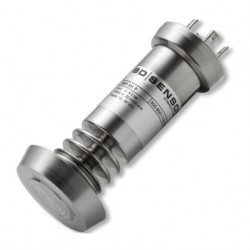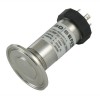 Hygienic measurement instrumentation are designed for use by the food, drink and pharmaceutical industries, which require a high level of cleanliness in their manufacturing processes.
Hygienic measurement instrumentation are designed for use by the food, drink and pharmaceutical industries, which require a high level of cleanliness in their manufacturing processes.
Hygienic applications require that all parts in contact with the process media must have a high level of cleanliness and include precautions against contamination.
To maintain hygiene in production processes, equipment needs to be designed so that it is possible to easily clean all parts in contact with the process media. Also the contact surface of these parts should deter the build up of bacteria and mould and other pathogens that may cause harm to human health.
 Food Grade Pressure Sensors - Food grade hygienic flush diaphragm pressure transducers & transmitters for measuring pressures or level of food, beverage or dairy media.
Food Grade Pressure Sensors - Food grade hygienic flush diaphragm pressure transducers & transmitters for measuring pressures or level of food, beverage or dairy media.
Hygienic Product Features
Hygienic instruments have highly polished stainless steel parts exposed to the process media and are installed using clamped seals.
Direct threaded type fittings are avoided since they introduce crevices which would attract the build up of process material over time and require dismantling for cleaning. Threads are used in some types of clamped fittings in order to pull two components together to make a seal, but are only used on the non-contacting external surfaces.
Material
The preferred type of material for hygienic parts is polished stainless steel 316L because it is easy to clean, can be welded without the introduction of another material and has good corrosion resistance to various media including cleaning agents.
Process Fittings
The types of process connections used for fitting hygienic pressure instrumentation are designed to reduce crevices and hidden spaces where residue from the process media can become trapped and lead to the growth of micro-organisms causing product contamination. A popular type of hygienic fitting is the Tri-clamp which uses a double hinged clamping ring that is tightened around two flanged surfaces separated by an elastomer O ring seal.
Food Grade Oil Fill
Some designs of pressure sensing technology include an oil-fill which is contained behind an thin metal isolation diaphragm. Since there is a risk that a thin and exposed diaphragm could be damaged and leak its contents into the process, it is necessary to use an oil that will not cause harm if accidentally mixed with the process media. The types of oil used include Peanut oil, Olive oil and Food grade silicone oils.
Industry Types
The types of industry that use hygienic pressure measurement equipment include food processing, breweries, drink production, pharmaceuticals, medicines, biotechnology and medical equipment.

